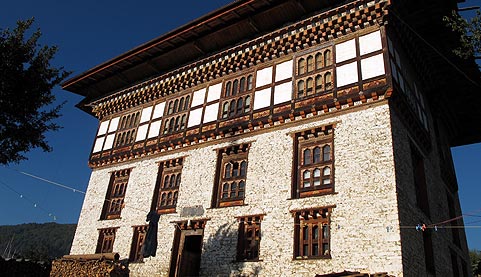Ura is a picturesque cluster village in Bumthang and it is of historical importance having yielded quite a number of famous political and religious figures. Many years ago, Tashi Wangmo, the lady of the house, came to Ura as a bride from nearby Shingkhar village. Tashi’s family also belongs to what was previously referred to as lam chojé, a lineage of religious nobility. However, such social classes were abolished by the third king.
Tashi’s house is located just below Ura Man Gi Lhakhang. The house is impressive and has plenty of rooms to accommodate a large number of people. The family was obligated to host important and often high ranking guests and therefore the home is one of the better equipped ones. It can get very cold in Ura during winter time so we suggest to visit during spring, summer and autumn. Ura is also well known for the yak choe (festival with mask dances) which takes place every spring, and the Masutaki Festival every August during mushroom season.
Tashi Wangmo is famous for her outgoing and straight forward nature as well as her generous and warm hospitality. As the nangi aum (lady of the house), Tashi has a lot of responsibilities and she is kept rather busy with various chores. Nevertheless, Tashi welcomes guests with ara and tea, ever ready for a chat,- she speaks very good English! Her cooking deserves extra mentioning,- it is very delicious! If you are interested, Tashi will happily teach you how to prepare Bhutanese ema datshi and momos. Tashi will probably also tell you about her time in Austria where she participated in an organic farmers exchange programme with Bhutan Network. In 2017 a dream came true for Tashi when a bread oven was built nearby her house. Chances are high that you will get to taste her delicious bread.
Visit Shingkhar village (3400 m) and even hike up further to Singmela pass from where you have a stunning view of the valley and the Himalayan mountain peaks. The footpath follows the old route to adjacent Lhuntse valley where the locals had to commute several times a year to barter, glean and take their cattle in the winter. Those days are over and the footpath is not maintained any longer.

